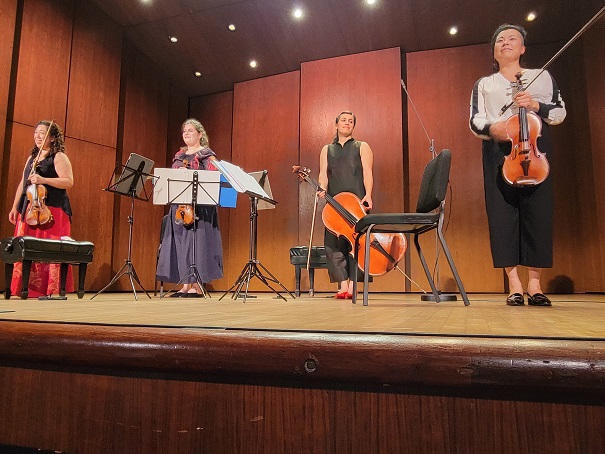Concert Diary: The Aizuri Quartet at the 92nd Street Y
November 4, 2021
New York, N.Y.
The music begins ferociously with an aggressive unrelenting energy. There’s a rhythmically jagged forcefulness here that makes you want to bang out the beats, no matter how irregular they may be. When the music does calm down briefly, the tension and dense textures remain.
This is the first movement of Jamaican composer Eleanor Alberga’s String Quartet No. 1 from 1993, and despite the modernist harmonic and rhythmic language, it is traditionally structured in three fast-slow-fast movements. What’s not traditional, however, is to give the three movements multilingual names:
The second slow movement has an austere magical beauty, while the third returns to the intensity of the first but with little tunes breaking out. At one point the cello becomes a walking bass, and a little later, all four instruments engage in a wonderful extended pizzicato section.
Eleanor Alberga’s own description of her work is too good not to quote here:
In the case of the first quartet I was propelled into an intense burst of creativity by a lecture on physics. The details of this lecture — who gave it, where it was given, and so on — are now lost to my memory, but what grabbed me was the realization that all matter — including our physical bodies — is made of the same stuff: star dust. So the first movement might be called “a fugue without a subject,” as particles of this stardust swirl around each other, go their separate ways, collide, or merge. The second movement might be described as “stargazing from outer space,” while the finale re-establishes gravity and earthbound energy.
Eleanor Alberga’s first String Quartet was performed last night in a wonderful concert by the Aizuri Quartet at the 92nd Street Y. Interestingly, the Aizuri showed up two months ago in my blog entry on what I called RGB String Quartets.
The Aizuri Quartet began their concert with two madrigals by the prolific early Baroque composer Barbara Strozzi (1619 – 1677). These two madrigals entitled “The Nightingale” and “The Modest Lover” were arranged specifically for the Aizuri by Alex Fortes. These were charming and lively episodic pieces that piqued our interest in this unusual composer.
After intermission, the Aizuri Quartet provided a second wallop in the evening by taking on the first of Beethoven’s late string quartets: No. 12 in E-flat Major, Op. 127, which I think of as “the one with the enchanting adagio variations” but which I believe I have described in more detail elsewhere.
From left to right during curtain calls, the members of the Aizuri Quartet are violinists Miho Saegusa and Emma Frucht, cellist Karen Ouzounian, and violist Ayane Kozasa:
